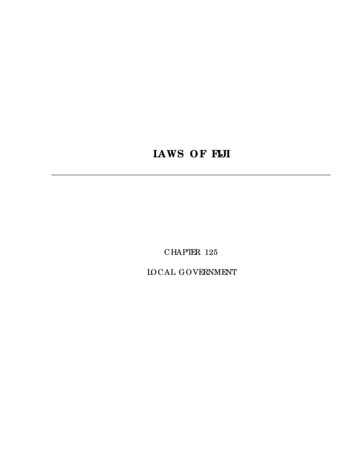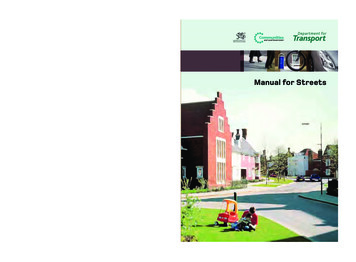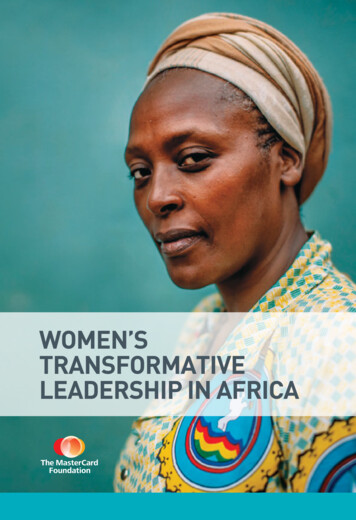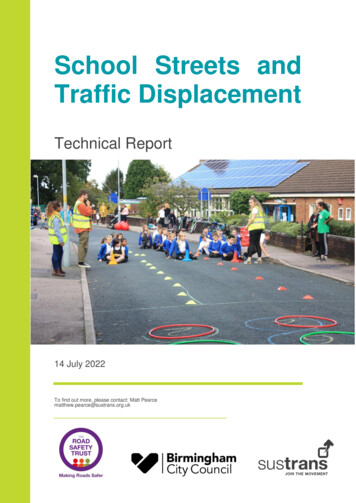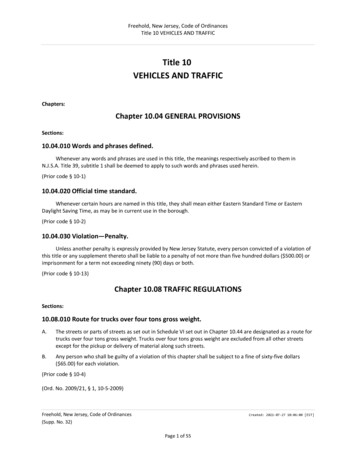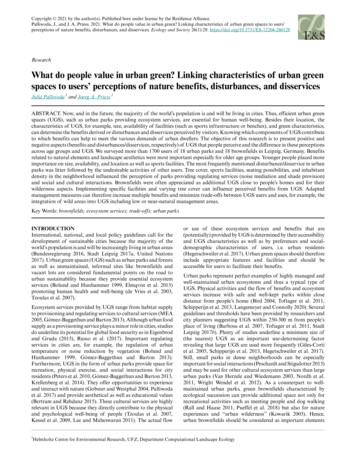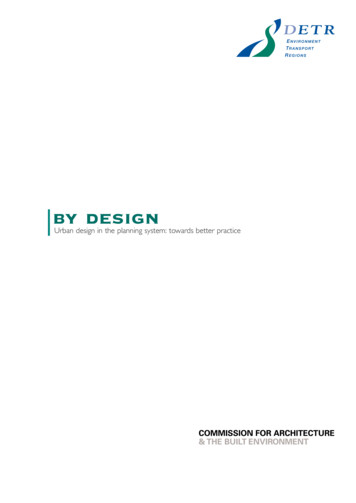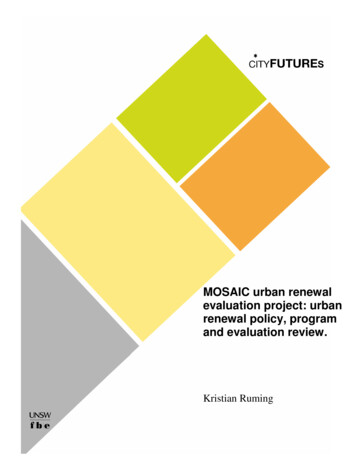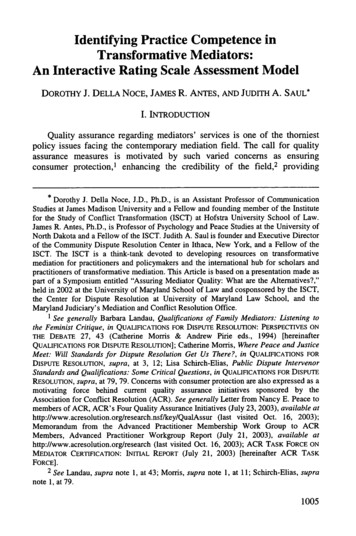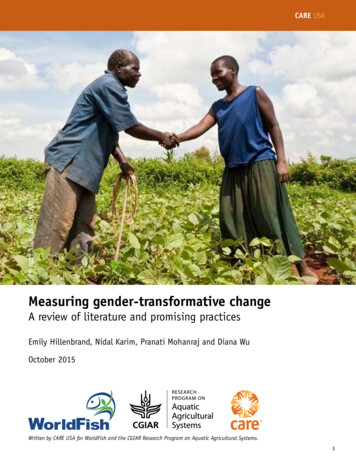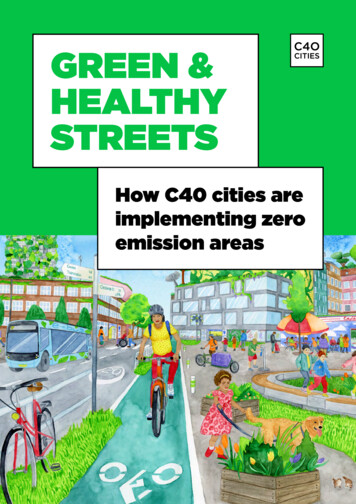
Transcription
GREEN &HEALTHYSTREETSHow C40 cities areimplementing zeroemission areas
C40 Cities connects 96 of theworld’s largest and most influentialcities committed to taking boldclimate action to create a healthierand more sustainable future for all.Representing 700 million citizensand one quarter of the globaleconomy, mayors of the C40 citiesare committed to delivering on themost ambitious goals of the ParisAgreement at the local level, as wellas to cleaning the air we breathe.This guidebook is produced withthe support of the TransformativeUrban Mobility Initiative (TUMI).TUMI is the leading globalinitiative on sustainable mobilityimplementation that is formedthrough the union of 11 prestigiouspartners. TUMI supports mobilityprojects globally and supportscity-level policy-makers with thetools to enable them to makedecisions that positively transformmobility in their cities. We believein a future that allows all citizensaccess to Sustainable Urban apbox.comLead author: Kate LaingReviewers: Daniel Firth, CristinaMiclea, Dolly Oladini, Lucy Mahoney,Carolynn Johnson, Jessica Jinn,Margarita Fernandez-Amresto Sanchez,Terje Elvsaas, Hilde Solli, Hyejung Yeo,Lauren Edwards, Valentino Sevino,Paulo Campus, Lucy Hayward-Speight,Greg Nelson.To learn more about the work of C40 and ourcities, please visit our website, or follow uson Twitter, Instagram, Facebook and LinkedIn
EXECUTIVE SUMMARYAs at Spring 2020, 35 global cities have setout to establish a significant area of theircity as zero emission by 2030 as part oftheir commitment to the C40 Green andHealthy Streets Declaration.Street based pilots: A hyperlocal initiativein which very strict access restrictions areintroduced on a few streets from 2020onwards with an expansion programmetowards 2030. Examples: OxfordThis document analyzes the approaches beingtaken by some leading cities to implementa zero emission area (ZEA). Designatinga significant area of the city as “zero emission”by 2030 will require holistic and multi-facetedthinking and a timetable of strategic actionsdesigned to shift the whole urban system ontoa zero emission trajectory.District-scale design: A plan to transforman entire area, beginning in 2020. A timetableof significant interventions to support shiftstowards public transport, walking and cyclingwhich ultimately will lead to less overallvehicles in the area by 2030.Examples: Oslo and AucklandWe have two main audiences in mind for thisanalysis: decision-makers in signatory citieswho are interested in comparing approachesand ambitions in other cities; and those innon-signatory cities who are contemplatingsigning the C40 Green and Healthy StreetsDeclaration and are seeking inspiration onhow they might achieve those commitments.To achieve a ZEA by 2030, cities are alreadyworking on interventions in 2020. Four distinctimplementation progressions are emerging:3Vehicle regulation cordons: Concentriccordons of urban vehicle access restrictions(UVARs), with the strictest regulations at thecentre, are being introduced. Dirty vehicles arebeing phased out and cleaner vehicles phasedin. By 2030, a clearly cordoned area of thecity will permit zero emissions vehicles only.Examples: London, Milan, Seoul and BarcelonaTimetable to a ZEA in 2030: a publishedpathway and timeline of interventions forthe area to 2030. Examples: Amsterdam
Foreword by Mark Watts,Executive Director C40 CitiesUrban planning that prioritises private carsover everything else creates gridlocked citiesin which pollution-belching vehicles poisonthe lungs of people forced to share the streetswith them. It’s also a system that perpetuatesinequalities by excluding anyone who can’tafford to run a motor vehicle.A quarter of global premature deaths arecaused by some form of human-inducedpollution; those same emissions are a majorcontributor to the climate breakdown thatposes even bigger risks to human healthand well-being.But instead of choking urban life, we cantransform the streets to make them workfor people, creating liveable streets wherecitizens can enjoy clean air and quiet roads.To date, 35 mayors have signed the C40Green and Healthy Streets Declaration,committing to people-friendly planningpolicies and accelerating the shift tozero-emissions vehicles.What is so significant about this declarationis the diversity of cities that have signed. IfBarcelona, Seoul, Seattle and Mexico City canestablish a zero emission area by 2030 – citiesof vastly different size, location and history –there is no reason for any city to hold backfrom adopting people-centred policies. Atthe same time, the ambition of a zero emissionarea by 2030 sends the signal to all vehiclemanufacturers that cities are demandingemission free products and services.The future of our cities is not one poweredby fossil fuels. Any business who ignores thatreality will be left behind.4Foreword by Daniel Moser,Management Head at TransformativeUrban Mobility Initiative (TUMI) GIZAll around the world, city mayors are takingbold action to transform urban mobilityto deliver a better future for humanityempowered by strong and clean mobility.TUMI is proud to support C40 Cities and ispleased to provide support in the compilationof this knowledge document which detailshow leading city signatories of the C40 Greenand Healthy Streets Declaration are planningto establish a major area of their city as zeroemission by 2030.If a city manages to improve the qualityof its streets by converting them intoinclusive, healthy and attractive spaces,the additional benefits that flow from sucha shift are remarkable: millions of pollutionrelated premature deaths avoided each year;economic growth from thriving communities;money saved from health budgets as publichealth improves thanks to more activelifestyles; less inequality between richand poor neighbourhoods, and reducedgreenhouse gas emissions.This is the joint vision of thriving citieswith enhanced economic, social andenvironmental performances in line withthe New Urban Agenda, the Agenda 2030and the Paris Agreement.At the TUMI partnership, we are unitedin one goal: changing mobility for the benefitof people and the environment by enablingpolicy makers to transform urban mobility.We believe in sustainable mobility fora better future.
CONTENTSEXECUTIVE SUMMARY3ZEA VISION6INTRODUCTION7ZEA CONCEPT510ZERO EMISSION AREAS CONCEPTZEA IMPLEMENTATION PATHWAYS1115CITY CASE OXFORDSEOULCONCLUSIONTECHNICAL NOTE – ZERO EMISSION AREASACRONYMS AND 3454647
ZEA VISION6
INTRODUCTIONTHE GREEN AND HEALTHYSTREETS DECLARATIONTHE ZERO EMISSIONAREA COMMITMENTIn 2017, C40 Cities launched the Green andHealthy Streets Declaration (GHS). As ofSeptember 2020, the Declaration has beensigned by 35 global cities.Achieving a zero emission area requiresa package of mobility measures deliveredin a coordinated and ambitious way withina deadline of 2030. All cities are implementingpolicies and incentives which promote thefollowing outcomes:Cities commit to two transformative actionsthat can shift cities onto the right trajectoryand reduce emissions from urban mobilityat the scale required to meet the ambitionof the Paris Agreement:1. Procure, with our partners, only zeroemission buses from 20252. Ensure a major area of our city is zeroemission by 2030This document focuses on the secondcommitment – to establish a significant areaof the city as zero emission by 2030 – andexplains how various C40 cities are planningto implement these areas by 2030.WHY ARE MAYORSCAMPAIGNING FORZERO EMISSION AREAS?Zero emission areasbring health, equity,local economy, safetyand security as well asenvironmental benefits.7 Significantly more trips by walkingand cyclingPublic transport priority and connectivityLess vehicles overall in the areaIncreasing the take up of zero emissionvehicles and phasing out fossil fuel vehiclesThe shift towards zero emission mobility willnot only reduce greenhouse gas emissions,it will result in less congestion, quieter cities,cleaner air, healthier spaces and safer roads.The ZEA commitment is transformative:catalysing the potential for mobility shiftswhich will improve the quality of life for allcitizens, deliver local economic gains andhelp tackle the global climate crisis.
Pathway showing the causal chain between an action (Green and Healthy Streets), its outputs, outcomes, final impact on theenvironmental, health and economic systems, and case studies.OUTCOMESOUTPUTSACTIONIMPLEMENTGREEN & HEALTHYSTREETSIncreasedwalkingand dfossil fuelvehiclesIncreasedcyclists andpedestriansIncreasedshare of publictransportLess carsoverallReducedGHGemissionsLess noiseImprovedair qualityMoregreen jobsLess deathand ncreasedzero emissionvehiclesImprovedgreen spacesand coverageIncreasedwater andheat ighbourhoodattractivenessIncreasedlocal n heatisland effect
LIMAMEDELLINQUITOMEXICO CITYLima’spedestrianisationof the historiccity centreled to 60%less car trafficand 23% morepedestrians.Medellin’sGreen Corridorshelp to reduceaverage citytemperatures by2 C and improveair quality.Switching 1,200old buses toelectric willmean 100,000TCO2e avoidedper year.189,600 cartrips and thus360t of CO2emissions wereavoided annuallyfollowing MexicoCity’s investmentin cycle AEstablishinga completelyzero emissionarea within theParis Ring Roadwould lead to385 prematuredeaths avoidedper year.The noisereduction fromBarcelona’sSuperblockscould avertan estimated160 preventablecardio vasculardeaths.Pedestrianisingthe historiccity centrewould result inone additionalyear of lifeexpectancyper citizen.Achieving 100%clean buses by2030 would leadto 60 additionaldays of lifeexpectancyper citizen.Switching thepublic transportfleet to EV buseswould achieve100 less hospitaladmissionsper year.LOS ANGELESLONDONLOS ANGELESMEXICO CITYLONDONGrowing thepublicly availablecharginginfrastructurein Los Angelesby 2025 wouldcreate 1,500new jobs.In London,walkingand cyclinginvestments inhigh streets andretail centresboosts spendingby 30%. Cycleparking delivers5 times theretail spendper squarekilometre thanthe same areaof car parking.Public transportinvestmentswill reduce timespent in trafficby 15% perday by cutting5 million vehiclemiles thatwould otherwisebe traveled.The potential netpresent benefitsof Mexico City’sbike lanes totalmore thanUS 65 million.This is almost6 times theoriginal costof the cyclinginfrastructure.EncouragingLondoners towalk and cyclefor 20 minutesevery day wouldsave a potential 1.7bn in healthcost over 25 years.9
ZEACONCEPT10
ZERO EMISSIONAREAS CONCEPTA ZEA is a multi-faceted interventionthat seeks to create a space where:– There are fewer vehicles overall– All trips are zero emissionIn all cities, a zero emission area is deliveredas a package of mobility measures, oftenby tying together several existing mobilityprojects with a coordinated and ambitiousapproach within a deadline of 2030. By doingso, cities can reduce their greenhouse gas(GHG) emissions from mobility in line withthe goals of the Paris Agreement.WHAT TYPES OF TRIPS ARE DEFINEDAS “ZERO EMISSION”?For the purposes of ZEAs, “zero emissions”means “zero tailpipe GHG emissions frombuses, trucks and cars”. This framing wasselected and endorsed by the leadingsignatory cities to the Green and HealthyStreets Declaration to ensure it wouldencourage the most significant improvementsin both air quality and carbon reduction.Although the definition is intentionallytechnology-neutral, the only vehicletechnologies currently on the marketthat are zero emission at tailpipe arehydrogen fuel cell (HFC) or batteryelectric vehicles (BEVs).11Although lifecycle emissions fromboth HFC and BEVs depend on howthe hydrogen and the electricity aregenerated, they offer the potential fora dramatic reduction in lifecycle emissionsas electricity generation is decarbonised.Significantly, other sustainable modesof travel that do not create tailpipe GHGemissions such as walking, bicycles, electriccargo bikes and so on are also included inthis definition. Further information on howGHS signatories define “zero emissions” canbe found in the technical note at Appendix A.
ZEMISSION AREAS:PILOTING THE FUTURE WE WANTESTABLISHING ZEASPROVIDES DEMONSTRATIONPILOTS FOR A CLIMATE SAFEMOBILITY SYSTEMC40 mayors are delivering a climatesafe future. This requires significantshifts in urban mobility to createa system of zero emissions, greenerstreets, healthy air, quieter roadsand cleaner urban transport. Theprocess of establishing a ZEAcreates a pilot or testing ground fortemporary interventions: a space toexplore the impact of interventions,experience and measure the benefitsof changes, and a focal point forcollaboration with with citizens,businesses and other partners.A ZEA is a space where a citydemonstrates the multi-facetedurban mobility transformation ina single, well-defined area and howthis transformation could improvepublic health, wellbeing and equity.The intention is that successfulinterventions can then be expandedand replicated across the city.12ZEAS WILL HAVE A NETWORKEFFECT ON THE WIDER CITYZEAs are “transformation pockets”which will increasingly influencemobility shifts and traffic reduction,and encourage more zero emissionmobility choices across the broadercity as they are established,replicated or expanded. For example,a ZEA might affect how peopledecide to get to and from that areaand influence what types of vehiclesenter or pass through it. Throughthese mechanisms, ZEAs have thepotential to create both direct andindirect network effects on mobilitydecisions in the wider city.ZEAS ARE OPPORTUNITIESTO PRIORITIZE AND INCREASEWALKING AND CYCLINGCreating a zero emissions mobilitysystem requires a significant increasein the proportion of journeysmade by walking and cycling, andreallocation of road space towardsthese modes of transport. Byrebalancing the urban realm, ZEAsallow for trials of walking and cyclingsolutions, and improved connectionsto mass transit, as replacements forvehicle traffic. The multiple benefitsof these interventions should behighlighted and explained, whetherthey relate to public health, airquality improvements, improvedpublic space, greater equity andsocio-economic prosperity.
ZEAS ARE OPPORTUNITIES TOPRIORITIZE PUBLIC TRANSPORTAND TRANSIT-ORIENTEDDEVELOPMENTEstablishing a ZEA requires masstransit solutions to be prioritized.ZEAs offer an opportunity to shiftthe balance of urban space towardstransit-oriented development –including connections to publictransport using walking and cycling –and to reduce reliance on privatevehicles. The benefits of transitoriented placemaking interventionsshould be highlighted, including linksbetween renewed public space andeconomic prosperity, as well as theimprovements in public health andair quality.ZEAS ARE OPPORTUNITIESTO INCREASE THE USE OFZERO EMISSION VEHICLESAs part of designing andimplementing a ZEA, cities can learnfrom local stakeholders about thedemand and supply of zero emissionvehicles within the pilot area.With this understanding, decisionmakers can develop strategies andpolicies that accelerate the use ofzero emission vehicles in the city,in public transport, freight and taxifleets in particular. A ZEA is alsoan opportunity to demonstrate analternative vision of a city where onlyzero emission vehicles operate, onewhich is quieter, and the air is cleaner.13ZEAS ARE OPPORTUNITIESTO ADVANCE ZEROEMISSION FREIGHTA sustainable future for urban freightmust come from two angles: morezero emission vehicles, and fewerunnecessary vehicle miles. ZEAsprovide an opportunity to engagethe freight and servicing industriesaround demonstration pilots andpossible challenges and solutions(e.g. EV model availability, EVcharging infrastructure, last-miledelivery models, kerbside loading/unloading). Cities and operators canfocus attention on the proposeddesign and regulation for the areaand experiment together on solutionsthat contribute to the placemakingaims of the ZEA. By collaboratingon the ZEA, they are also creatinga context for a broader discussionon the pathways and obstacles toachieving zero emissions freight inthe future across the city.ZEAS ARE COMMUNITYENGAGEMENT TOOLSPublic and stakeholder engagementwill be critical to the ambitionof achieving a completely zeroemission area by 2030. To engagethe community and make thecase for ZEAs it will be importantto articulate the anticipated benefitsof a systemic change towardsgreener, healthier more prosperouscities. Moving towards a ZEA by 2030provides an opportunity for citiesto anticipate, measure, evaluate andultimately provide evidence of thebenefits of ZEA interventions. Theprocess will present opportunities fortactical urbanism and projects thatdemonstrate the benefits of ZEAs willhelp gain buy-in from stakeholders.This in turn will support replicationand expansion in the future.
MAYORAL DELIVERYMayoral powers, mandates and functionsvary widely amongst C40 cities, and thecommitments of the Green and HealthyStreets Declaration will be delivered throughdifferent strategies in different cities.Many mayors have some authority overcity roads and bus assets, and several haveregulatory power over certain fleets, suchas taxis. Yet for other mobility assets – likeprivate vehicles or bicycles – cities’ powersare usually more limited. For example,they may only be able to regulate parking,or designate the amount of road spacemade available.To give a sense of the range of mayoralpowers, we’ve outlined six different typesof mayoral influence in the figure below.Most city mayors are able to exert some orall of these types of power, to some degree,to build a city’s capacity for climate action –for example, by creating a ZEA.C40 research1 shows that stronger mayoralpowers do not necessarily lead to moreclimate action, or air-quality action in a city.Cities with more limited mayoral power, orpowers that might be considered “weaker”such as vision setting, have shown they candrive positive city-wide changes, includingZEAs. These cities are working at scale,using innovative approaches to encourageother actors to join them in climate actionwhere they cannot necessarily take directaction themselves.In fact, most cities collaborate with an arrayof partners to multiply their influence andimpact. These might include national and stategovernments, civil society, intergovernmentalinstitutions, the private sector and academia.For instance, a city might collaborate withnational government on the implementationof a vehicle emissions regulation schemeor work with the freight industry on a zeroemission vehicle pilot scheme. By findingand working towards shared goals, mayorsand partner-organisations are able to achievemore than either could alone.TYPE OF POWEREXPLANATIONEXAMPLESCommandingpowerA mayor uses regulation andenforcement to create changeand enact policy.Shifting the city taxi fleet towards zero emissionvehicles using licence regulation or prioritising curbsideor area access for zero emission vehicles during peakloading times.ImplementingpowerA mayor acts through the deliveryof a project or programme.Making significant interventions to the urban realmto prioritize pedestrians, cyclists and access to transitor establishing an electric vehicle (EV) fast-charginghub for taxis to accelerate the take up of EVs by taxis.ProvidingpowerMayoral influence is characterisedby a high level of control overservice delivery.Committing to electrify the municipal fleetby a certain date or implementing preferentialprocurement regulations which favour serviceproviders with zero emission offerings.LegislatingpowerA mayor achieves progress by settingpolicy and legislation that requiresothers to act.Setting building regulations for new developmentswhich will support a ZEA such as setting a maximumnumber of parking spaces or requiring residentialEV charging spaces.CollaboratingpowerA mayor commonly acts in partnershipwith other actors to leverage theirrespective powers.Working with the local transit authority to set targetsand break down barriers for the procurement of electricbuses for the city fleet or working with local innovationincubators to better understand barriers to privatesector transition.Vision settingpowerA mayor may sometimes have limitedpower to take action directly but stillinitiates change by setting a visionand making a political case for change.A mayor can create an attractiveenvironment within which otherscan act.Using the Mayoral profile to draw media attention toinequalities in the mobility system and draw clear linksto the unfairness of air quality impacts or conveningcollaborative solution finding initiatives betweenbusinesses and academia around a vision for a ZEA.14
ZEA IMPLEMENTATIONPATHWAYSAs at Spring 2020, the Green and HealthyStreets Declaration has been signed by35 global cities. All cities are implementingpolicies and incentives which will promotethe following outcomes: Significantly more trips by walkingand cyclingPublic transport priority and connectivityLess vehicles overall in the areaIncreasing the take up of zero emissionvehicles and phasing out fossil fuel vehiclesThere are four different implementationapproaches emerging among cities. Somecities are combining different approaches inan overall strategy. Others are using theseapproaches as a pathway in itself, progressingfrom one stage to another as the ZEA matures.Street-based pilots Improves walking andcycling infrastructure Experiments with freight access Engagement with stakeholders,businesses and citizens Establishes a flagship streetDesign the ZEA at a district scale Sets the scale of the ZEA Significantly improves walkingand cycling infrastructure Increases public transportpriority and connectivity Reduces vehicles in the area Engagement with stakeholders,businesses and citizens15The ZEA implementation pathway, thereis constant engagement with communities,communicating and providing evidence ofthe benefits that a zero-emission area willhave for the urban environment, for healthand for the economy.Cities are also investing in support forthe accelerated take up of zero emissionalternatives to assist citizens, businessesand stakeholders with the shift away fromfossil fuel vehicles.In the city case studies following, we haveused the icons above to signal where, alongthe trajectory of ZEA implementation, a cityis currently progressing.Establish vehicleregulation cordon(s) Reduces vehicles in the area Disincentivises dirtier andfossil fuel vehicles Incentivises take up of zeroemission vehiclesPublish a clear timetableto achieve a ZEA by 2030 Sets the vision for the ZEA Makes the pathway clearto stakeholders Establishes the deadline
Example of a Zero Emission Area implementation timeline.Timedpriorityaccessfor ZEVsLaunchZEAfreightpilotRoll-outnew cyclelanesEstablishcleantaxis ctfinishedLaunchclean buscorridorthroughZEAOnly zeroemissiontaxis inZEA20252030ZEAESTABLISHED
CITY CASESTUDIES17
AMSTERDAMESTABLISHING AN AREA IN 2020Amsterdam is well established as a globalleader in prioritising walking and cyclingand public transport trips, so is working froma strong base in its ambition to make a majorarea of the city a zero emission area by 2030.In April 2019, Amsterdam published theClean Air Action Plan with the aim ofachieving emission free mobility by 2030(i.e. the entire city of Amsterdam will bea zero emission area by 2030).Amsterdam currently has five low emissionzones where vehicles that cause the mostpollution are banned. Over time, these zoneswill be expanded and regulations tightened.Increasingly they will become zero emissionzones, and petrol, diesel or gas vehicleswill not be permitted.The first important milestone is, from 2020,vehicles with diesel engines are excludedfrom the city centre area. 2PLAN TO ACHIEVE A ZEA BY 2030Between 2025 and 2030, Amsterdam willsteadily expand the zones from the city centreso that all motorized traffic in Amsterdam willbecome emission free. This approach usesa concentric expansion that has already beensuccessful for a low-traffic Amsterdam andthe regulation of coaches. Furthermore, asan extra measure to eliminate upstream CO2emissions, all of the electricity and hydrogenrequired for transport in Amsterdam will begenerated sustainably by 2030.18In the Amsterdam Clean Air Action Plan, thepathway to a zero emission city is summarizedin two key milestones: 2025: All traffic including taxis, passengervehicles, pleasure craft and municipalferries, but with the exception of privatecars and motorbikes must be emission freewithin the A10 ring road.2030: All traffic within the built-up areamust be emission free.
SUPPORTING ZEROEMISSION ALTERNATIVES The Amsterdam Clean Air Action plan outlinesthe following approaches to achieve the policyambition of emission free Amsterdam by 2030.Communication. Clearly explain theimportance of clean air and suggestideas for personal action (give peoplea sense of engagement with thepossibilities), including:Facilitation. Make the transition toa clean alternative possible (the alternativeis realistic), including: A campaign to inform everyoneof their role in creating clean airMaking it easier to choose the cleanoption, with the municipality settingthe right exampleStimulation. Make the transitionto a clean alternative appealing(the alternative is enticing), including: Continued use of various subsidiesto promote the affordability of emissionfree transportUsing privileges to reward early adoptersContinued development of botha demand-driven EV charging networkand intensifying charge-point installationin anticipation of demandMaking the charging infrastructuresmarter to increase the capacityof the EV charging networkIncreasing EV charging in car parksand at private locationsRegulation. Compel the transition toa clean alternative (the stick as well asthe carrot), including: Area-specific measures for emission freetraffic on a number of very busy streetswhere the air quality is particularly bad Intensification and geographic expansionof current environmental zonesIntroduction of a new environmental zoneIntroduction of emission free zonesgebied2025Uitstootvrij gebied binnende Ring A10 in 2025Voor OV-bussen, touringcars, passagiersvaart, taxi’s,bestel- en vrachtwagens, pleziervaart, GVB-veren(brom- en snorfietsen hele bebouwde kom) Uitstootvrij Amsterdam in 2030Voor OV-bussen, touringcars, passagiersvaart, taxi’s,bestel- en vrachtwagens, pleziervaart, GVB-veren,brom- en snorfietsen, personenauto’s en motoren gebied2030Uitstootvrij AmsterdamThe key milestonesin Amsterdam’sZoneringVerkeerClean Air Action Plan. In 2020, following the COVID-19 crisis, the Deputy Mayor inCharge of Air Quality and Mobility cancelled a plan to allow only zero emission buses and coaches in the inner city from2022. Amsterdam’s current zero emission milestones are reflected in the illustration above.Source: Amsterdam Clean Air Action Plan19
THINKING ABOUT ZEROEMISSION FREIGHTIn 2019, in the Netherlands, the NationalClimate Agreement defined a seriesof measures to be taken nationally toreduce greenhouse gas emissions byat least 49 per cent by 2030, with 1990levels as the baseline. The Agreementset out a requirement that the 30–40largest cities in the Netherlands introducezero emission zones for freight by 2025as one key action for sustainable mobilityand logistics.This requirement built on a voluntaryZero Emission City Logistics Green Dealin 2014, which was signed by a numberof Dutch cities including Amsterdam,The Hague, Rotterdam and Utrechtand over 50 Dutch companies, andwhich was launched by the nationalgovernment to foster partnershipsin support of the same goal.Setting a long-term goal. All vehicles in thecity emission-free in 2030.Amsterdam is already an establishedcycling city and a frontrunner in the fieldof electric vehicles, and in the coming yearsefforts to promote these modes will befurther intensified.Amsterdam has a high ratio of charginginfrastructure per capita. Residents who buyan electric car can apply for a charging stationin their neighbourhood, and the municipalitycan provide extra charging stations. At presentthe majority of EV charging infrastructureA 2019 research report – ChargingInfrastructure for Electric Vehicles inCity Logistics – looked in depth at thekind of charging infrastructure that wouldbe required in a city such as Amsterdamif BEVs were used to make zero emissionzones possible for city logistics.3The research used data from CBS(Statistics Netherlands) on the vansand trucks entering Amsterdam’slow-emission zone, and the authorscalculated where demand for chargingpoints will probably be greatest.Estimates were also made of theprojected impact on the power gridand required number of charging point.Based on these results, and the choicesmade, a vision emerges of where, whenand how fast vehicle charging mighttake place, allowing grid operators andmunicipal authorities to develop plansin terms of both charging infrastructureand spatial planning.is on-street and EV drivers have priority forparking and loading spaces. For residents andcompanies that switch to EVs, there is supportin the form of advice and/or subsidies.“ Dirty substances in the aircut more than a year fromthe life of every inhabitantof Amsterdam.”Foreword by Sharon Dijksma, Alderman Air Quality,Amsterdam, Amsterdam Clean Air Action Plan(April 2019)More information on Amsterdam:Amsterdam Clean Air Action Plan Charging Infrastructure for Electric Vehicles in City Logistics (2019)EV Charging Infrastructure: A quick guide for cities – a joint 2020 report from
year of life expectancy per citizen. Achieving 100% clean buses by 2030 would lead to 60 additional days of life expectancy per citizen. Switching the public transport fleet to EV buses would achieve 100 less hospital admissions per year. Public transport investments will reduce time spe
